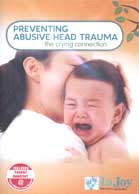
Preventing Abusive Head Trauma-The Crying Connection 2013
Distributed by InJoy Videos, 7107 La Vista Place, Longmont, CO 80503; 800-326-2082
Produced by Sara Aderhold
Directed by Sara Aderhold
DVD, color, 15 min.
Sr. High - General Adult
Parenting, Child Abuse, Child Development
Date Entered: 03/27/2014
Reviewed by Lori Widzinski, Multimedia Collections and Services, University Libraries, University at Buffalo, State University of New YorkThis first-rate production, Preventing Abusive Head Trauma – The Crying Connection is a “must-have” purchase for public libraries. The primary audiences—expectant parents, new parents and child caregivers—will find a program packed with essential information and tips for dealing with the stress often brought on by a newborn’s cries. Academic libraries with health sciences collections may want to add it as part of a patient or consumer health collection.
InJoy Videos consistently produces top-notch programs on pregnancy, parenting, infant care and young child care, and this DVD is a wonderful addition to their catalog. The 15 minute running time is perfect for our collective sound bite mind set. Producer and director Sara Aderhold manages to get all the important information about abusive head trauma, or Shaken Baby Syndrome, into that brief time frame without it feeling rushed or incomplete.
Interviews with new parents and a child abuse pediatrician coupled with statistics, animation, and a calm, clear, succinct narration form the basis for this highly recommended production. The chapter headings give a good overall description of the program content: Introduction, Crying and Abusive Head Trauma, When to Take a Time Out, and How to Create a Crying Plan.
Using simple, yet very effective animation, it is easy to understand what happens to the baby’s soft, underdeveloped brain when head trauma occurs. Crying is the number one trigger for abusive head trauma, and usually happens between 3 and 8 months of age. It is a crime, and it is completely preventable. Most people probably don’t realize the lasting effects of a blow to a baby’s head, including paralysis, seizures, and other long term problems. Going beyond what other videos on the topic tend to do, Preventing Abusive Head Trauma puts forth straight forward ideas for parents to follow to avoid a possible tragedy. Taking time to control their frustration, letting the baby cry for a few minutes while you regain your composure, and calling other trusted caregivers for help are all part of knowing when to “take a time out.” For parents, creating a “crying plan” for dealing with a crying baby may include knowing when they’re too tired, making a list of people who can help, simply holding and rocking their baby, or getting involved with a play group.